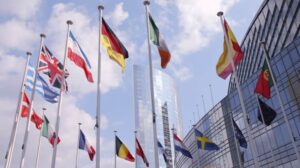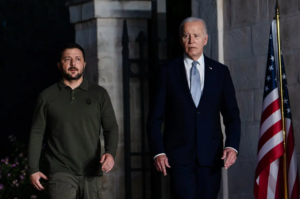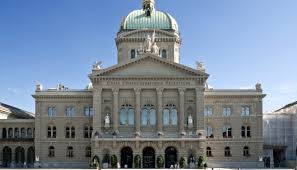
Italy and Spain have made it clear that they are not ready to support the European Union’s proposal to allocate around EUR 40 billion in military aid to Ukraine this year, with each country contributing according to the size of its economy, Reuters reported on Tuesday.
Following a meeting on Monday of foreign ministers from the 27 EU member states in Brussels, Kallas said her proposal had “broad political support” and discussions were now moving to the details.
Diplomats said the proposal has some support from northern and eastern European countries. But some southern European capitals were more reticent, reflecting a division between those geographically closer to Russia, which have given more aid to Ukraine, and those farther away, which have given less, as a percentage of their economies.
According to the Kiel Institute for the World Economy think tank, Estonia, Denmark and Lithuania lead Europe in this area, allocating more than 2 percent of their GDP to aid Kiev between January 2022 and December 2024. At the same time, Italy, Slovenia, Spain, Portugal, Greece and Cyprus are among those who have allocated the least, committing less than 0.5% of their GDP.
Speaking ahead of the meeting, ministers from Italy and Spain – the EU’s third and fourth largest economies – said it was too early to take a final position on the proposal.
Italian Foreign Minister Antonio Tajani said the proposal would need to be discussed in detail in light of upcoming events. “We are waiting for a phone call between Trump and Putin to see if there will be any steps forward to achieve a ceasefire,” he said, adding that Italy must also find money to increase its own defense spending. “There are many expenses that need to be addressed,” he added.
Spanish Foreign Minister Jose Manuel Albares said: “We will see how the debate goes, but there is no decision on this issue yet.”
Albares said Spain had already pledged 1 billion euros in military aid to Ukraine this year. He said Madrid did not have to “wait for the High Representative (Callas – IF-U) to make any proposal” to show that Kiev could count on his support.

More than 90% of what Denmark does in terms of support for Ukraine is related to weapons and defense equipment, this is a prerequisite for Ukraine’s survival as a nation, Danish Ambassador to Ukraine Ole Egberg Mikkelsen said.
“Denmark has been very active in terms of supporting Ukraine with defense equipment and weapons. I usually say that we do three things in Ukraine: weapons, weapons and weapons,” he said while speaking to the media on the margins of the U-Lead with Europe event on Tuesday.
At the same time, the ambassador stressed that Denmark also implements important civilian programs.
“But more than 90% of what Denmark does in Ukraine is related to weapons and defense equipment. And this, of course, is a prerequisite for Ukraine’s survival as a nation. If you are not armed, you cannot survive. This is very important for Denmark,” the diplomat emphasized.
And in addition, he recalled the implementation of the “Danish model” of support for Ukraine’s defense industry, which actually finances the purchase of weapons and defense equipment directly from Ukrainian manufacturers.
“And it turned out to be very, very innovative and very effective. This is something that we want to continue because we want Ukraine to stand firmly on its feet, including when it comes to weapons and defense equipment. And you have a huge potential,” the diplomat said.

U.S. and European officials are struggling to honor their pledge to use Russian assets to aid Ukraine.
A long-awaited plan to help Ukraine rebuild using Russian money is in limbo as the United States and Europe struggle to agree on how to construct a $50 billion loan using Russia’s frozen central bank assets while complying with their own laws.
The fraught negotiations reflect the challenges facing the Group of 7 nations as they attempt to push their sanctions powers to new limits in an attempt to punish Russia and aid Ukraine.
American and European officials have been scrambling in recent weeks to try to get the loan in place by the end of the year. There is added urgency to finalize the package ahead of any potential shifts in the political landscape in the United States, where support for Ukraine could waver if former President Donald J. Trump wins the presidential election in November.
But technical obstacles associated with standing up such a loan have complicated matters.
Group of 7 officials grappled for months over how to use $300 billion in frozen Russian central bank assets to aid Ukraine. After European countries expressed reservations about the legality of outright seizing the assets, they agreed that it would be possible to back a $50 billion loan with the stream of interest that the assets earn.
The solution was intended to provide Ukraine with a large infusion of funds without providing more direct aid from the budgets of the United States and European countries. It also allowed western allies to make use of Russia’s assets without taking the step of actually spending its money, which many top officials in Europe believed would be illegal.
But differences in the legal systems in the United States and in Europe, which both plan to provide the money up front, have made it difficult to structure the loan.
The European Union, where most of Russia’s central bank assets are held, is required to renew the sanctions that have frozen Russia’s assets every six months.
Because of this E.U. law, the White House’s Office of Management and Budget has determined that there is a certain amount of risk associated with the loan and that, unless the E.U. changes its sanctions laws, Congress must approve additional funding for Ukraine to account for that risk. But securing additional funding for Ukraine is logistically and politically unlikely, leaving the loan in limbo.
“They thought a big, nice, shiny announcement would force the bureaucrats to find a way, and here we are three months later,” said Charles Lichfield, deputy director of The Atlantic Council’s GeoEconomics Center.
E.U. officials have been reluctant to change their sanctions laws to accommodate the United States because doing so requires the support of all 27 member nations. Europe could put forward the entire loan, and some officials there have suggested that it do so, but the United States believes that it is important for the Group of 7 to act in unison.
In recent days, European officials have been discussing the possibility of extending the sanctions review period to 12 or 36 months. While that would reduce the costs that the United States would incur in backing the loan, Congress would still most likely need to approve new money or redirect existing funds because of the risk that the sanctions might not be extended.
“Like U.S. officials, I’m disappointed that Europeans effectively took the summer off after making this commitment and only really started to address this topic this month,” said Philip Zelikow, a State Department official in both Bush administrations and a senior fellow at Stanford University’s Hoover Institution. “And some are creating new obstacles, for reasons that will not withstand much scrutiny.”
Mr. Zelikow, who has called for the United States to use the Kremlin’s assets to rebuild Ukraine, added, “Russia is counting on winning a war of attrition, including against Ukraine’s economy.”
The United States has provided about $175 billion in aid to Ukraine since Russia’s invasion began in early 2022. With the war showing no signs of abating, the International Monetary Fund expects Ukraine’s economy to slow in the second half of the year and for inflation to spike as attacks on its energy infrastructure persist.
The I.M.F. this month agreed to give Ukraine access to another $1.1 billion in financial assistance as part of a lending program that it approved last year.
A senior Biden administration official, who requested anonymity to speak about internal discussions, said that the United States needed assurances that codify the commitments of the Group of 7 leaders, who had agreed that Russia’s sovereign assets would remain immobilized until the war ends and until Russia repays Ukraine for the damage it had caused. Another senior U.S. official said that there was urgency to reach an agreement with Europe in the next few weeks and noted that the differences were more technical than ideological.
The loan has been difficult to devise because of a variety of risks associated with it. For instance, falling interest rates could diminish the value of the returns on the frozen Russian assets, most of which are held in Europe.
U.S. officials have looked into different scenarios for accounting for that risk. Although about $5 billion of Russian central bank assets are held in the United States, the Biden administration is not prepared to seize those funds to back the loan.
A spokeswoman for the Office of Management and Budget said that some of the funds that Congress had already allocated to support Ukraine could be used to cover potential costs associated with the loan. However, it is not clear if redirecting those funds for that purpose would require congressional approval.
The deliberations over the funds come as fighting between Ukraine and Russia is intensifying and as President Biden is on the verge of clearing the way for Ukraine to launch long-range Western weapons deep inside Russian territory.
The U.S. election in November is also weighing on the fate of Ukraine. At a presidential debate last week, Mr. Trump would not say if he wanted Ukraine to win the war and would only reiterate that he would work to swiftly end the fighting.
“It’s about getting it done before the election,” Mr. Lichfield said of the loan. “So the $50 billion is there to replace the U.S. if need be.”

A Swiss parliamentary committee voted late on Thursday night in favor of allocating 5 billion Swiss francs ($5.5 billion) in aid to Ukraine, Reuters reports.
“A Swiss parliamentary committee voted late on Thursday night to allocate 5 billion Swiss francs ($5.5 billion) in aid to Ukraine as part of a broader package aimed at boosting the defense capabilities of neutral Switzerland. Backed by lawmakers from center-left and center-right parties, the upper house’s security committee approved the package, which provides 10.1 billion francs in additional funds for the army, along with the amount for Ukraine,” it said.
The plan was adopted by 8 votes to 5, with right-wing parties opposed. It is noted that it will have to pass a number of parliamentary hurdles before the plan becomes law.
“The parliament statement said the multi-billion dollar package was conceived as an extraordinary contribution to Swiss security and ‘peace in Europe’ in the wake of the war Russia is waging against Ukraine,” the statement said.
The parliament also said that the Ukrainian part of the package is aimed at supporting the reconstruction and repair ofeveryday infrastructure necessary for life in Ukraine.